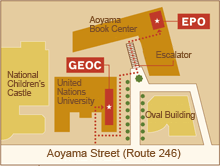Summary
Understanding the basic process of partnerships
 The processes through which partnerships progress are quite diverse. They vary considerably according to regional factors, the initiative being implemented, the type and number of stakeholders involved, and even social timing. We start by explaining the basic processes of partnerships in four steps, and then use some hypothetical examples to map changes in activities. These are just the basic steps to the processes. In reality, some activities might start mid-process, or even move back and forth between steps. There are a diverse range of workplaces as well, so please read the following four partnership case studies to get a better understanding of the processes.
The processes through which partnerships progress are quite diverse. They vary considerably according to regional factors, the initiative being implemented, the type and number of stakeholders involved, and even social timing. We start by explaining the basic processes of partnerships in four steps, and then use some hypothetical examples to map changes in activities. These are just the basic steps to the processes. In reality, some activities might start mid-process, or even move back and forth between steps. There are a diverse range of workplaces as well, so please read the following four partnership case studies to get a better understanding of the processes.
Step 1. Gathering
Start by creating opportunities for all stakeholders to gather as one. In addition to governments and nonprofit organizations with a strong awareness of issues, it is important that other groups with ties to the community also participate, including companies, schools and community-based organization. If it is difficult to immediately form a committee, it may be useful to start with preparatory talks, or get-togethers and other informal discussions. Regardless of which groups are invited to attend though, it is important to start by explaining the value of the opportunity you are creating. An awareness of issues alone will not lead to progress. You need to create an open environment that encourages stakeholder involvement and mutual dependence.
Step 2. Sharing
Once the stakeholders are together and gradually recognizing each other, reinforce the significance of the gathering. For example, a partnership could come together to clarify and solve local issues such as illegal dumping of waste, or to create a vision for the future. What is important is that both issues and future visions are clearly shared. Getting caught up in single issues tends to create one-off initiatives that make it difficult to see other problems. Equally, with a vision only, progress might stall after the initial excitement, or fail due to lack of feasibility. It is important to share the issues to be solved, and what sort of society will be created as a result.
Step 3. Implementation
When a direction has been established, it is time to move to action. Start by assigning roles. Partnerships bring together a range of different groups, so there will naturally be a variation in the amount of resources, such as manpower or information, that each can provide. Partnerships will not last long if a single organization monopolizes all the roles. So what criteria should you use? Rather than the amount of resources each party has, whether their strengths are being utilized is more important. Local communities will act if people can bring together and utilize such things as local organization networks not utilized in previous collaborations, or expertise based on the experience of primary industry workers. Like this, mutual respect for each other’s strengths will result in partnerships where the hard work can be shared.
Step 4. Expansion
Although some projects can be short-lived, partnerships themselves are basically never-ending. This is because expanding your network brings to light new issues that should be addressed. You can gradually create a virtuous circle by continually asking whether all necessary stakeholders are in place to tackle the next issue, or if not then who should be invited to participate and how to ask them.
It is important to not be afraid of change. Partnerships involve other parties, so unexpected events will frequently occur. They might make things difficult, but they are also opportunities for self-change and growth of your organization. It is important to always be aware that when you come across new issues, you can overcome those issues through partnerships.
Information
Publisher: Global Environment Outreach Centre
Language: Japanese
Publication Date: 2016/02

















